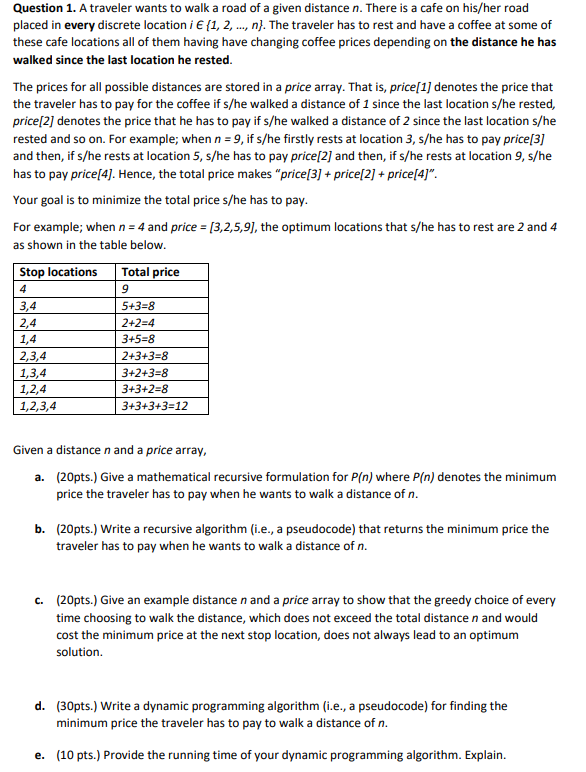
Question 1. A traveler wants to walk a road of a given distance n. There is a cafe on his/her road placed in every discrete location i E {1, 2, ..., n}. The traveler has to rest and have a coffee at some of these cafe locations all of them having have changing coffee prices depending on the distance he has walked since the last location he rested. The prices for all possible distances are stored in a price array. That is, price[1] denotes the price that the traveler has to pay for the coffee if s/he walked a distance of 1 since the last location s/he rested, price[2] denotes the price that he has to pay if s/he walked a distance of 2 since the last location s/he rested and so on. For example; when n = 9, if s/he firstly rests at location 3, s/he has to pay price[3] and then, if s/he rests at location 5, s/he has to pay price[2] and then, if s/he rests at location 9, s/he has to pay price[4). Hence, the total price makes "price[3] + price[2] + price[4)". Your goal is to minimize the total price s/he has to pay. For example; when n = 4 and price = (3,2,5,9), the optimum locations that s/he has to rest are 2 and 4 as shown in the table below. Stop locations Total price 9 3,4 5+3=8 2,4 2+2=4 1,4 3+5=8 2,3,4 2+3+3=8 1,3,4 3+2+3=8 1,2,4 3+3+2=8 1,2,3,4 3+3+3+3=12 4 Given a distance n and a price array, a. (20pts.) Give a mathematical recursive formulation for Pln) where P(n) denotes the minimum price the traveler has to pay when he wants to walk a distance of n. b. (20pts.) Write a recursive algorithm (i.e., a pseudocode) that returns the minimum price the traveler has to pay when he wants to walk a distance of n. C. (20pts.) Give an example distance n and a price array to show that the greedy choice of every time choosing to walk the distance, which does not exceed the total distance n and would cost the minimum price at the next stop location, does not always lead to an optimum solution. d. (30pts.) Write a dynamic programming algorithm (i.e., a pseudocode) for finding the minimum price the traveler has to pay to walk a distance of n. e. (10 pts.) Provide the running time of your dynamic programming algorithm. Explain







